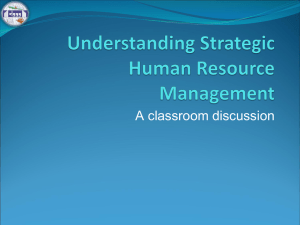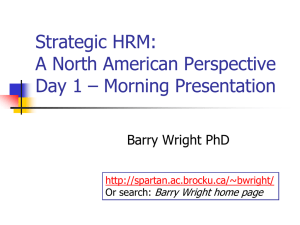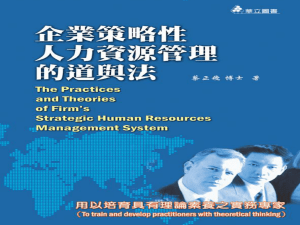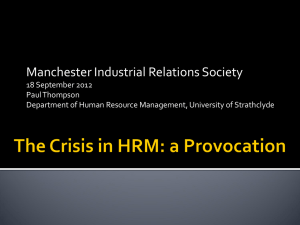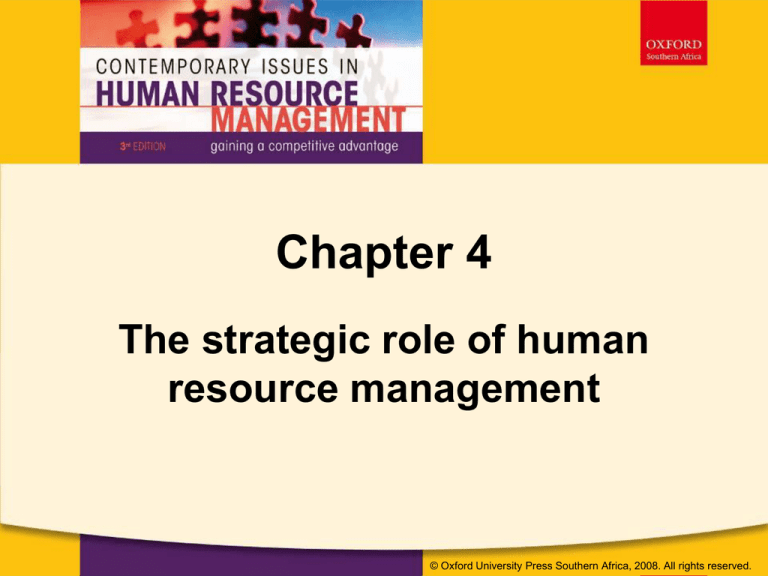
© Oxford University Press Southern Africa, 2008. All rights reserved.
Chapter 4
The strategic role of human
resource management
© Oxford University Press Southern Africa, 2008. All rights reserved.
© Oxford University Press Southern Africa, 2008. All rights reserved.
Learning outcomes
After reading this chapter you should be able to:
• explain the basic principles of strategic HRM
• discuss critically the relationship between
strategic management and strategic HRM
• describe the design of a human resource
strategy
• describe the various models of strategic HRM
© Oxford University Press Southern Africa, 2008. All rights reserved.
Chapter Content
• Opening case: Happy Sky Company: aligning
human resource functions with strategic objectives
• Introduction
• Major approaches and theories related to strategic
HRM
• Broad concepts underlying theories
• Emergence of strategic HRM
• Relationship between strategic management and
strategic HRM
• SHRM models
Linking HR practices with the
strategic initiatives of the company
OUP insert figure 4.1, omit background of this slide if needed
© Oxford University Press Southern Africa, 2008. All rights reserved.
Basic principles of SHRM
• Tsui defined concept as follows:
– focus on organisation-wide human resource concerns and
addresses issues that are related to the firm's business,
both short-term and long-term
– particularly useful for designing specific human resource
programmes, policies, systems or management practices
at the organisational or business level
– line executive is the most important constituent for the
human resource function
– supports the 'proactive' approach where HR
professionals participate in the strategic planning process
and can potentially influence the formulation of the
company strategy
© Oxford University Press Southern Africa, 2008. All rights reserved.
Basic principles of SHRM
• Dyer & Holder provide more substance when remarking that:
– SHRM consists of 3 major tasks, assure that the HR
issues and implications of various alternatives or
proposals are fully considered, establishing HR goals and
action plans to support the business strategies and
working with line managers as principal clients to ensure
that established action plans are indeed implemented
• two major issues/aspects need to be in place within the
organisation before the SHRM process can function
successfully:
– the presence of a strategic management process
– the restructuring of the HRM function itself
© Oxford University Press Southern Africa, 2008. All rights reserved.
Basic principles of SHRM
• if the organisation has no process by which to engage in
strategic management at the corporate and business level,
it will not be possible for the HR function to develop a
strategic thrust, since the HR strategy flows from the
corporate or business strategy
• as the HR function will be evolving from a reactive
administrative focus, it will have to be reorganised to
address its strategic responsibilities
• HR system must have its operational house in order before
it can afford the luxury of concentrating on the formulation
and implementation of an HR strategy
© Oxford University Press Southern Africa, 2008. All rights reserved.
Basic principles of SHRM
• strategic management = process that deals
with:
– organisational renewal and growth
– development of strategies, structures and
systems necessary to achieve renewal and
growth
– organisational systems needed to effectively
manage the strategy formulation and
implementation processes
© Oxford University Press Southern Africa, 2008. All rights reserved.
Basic principles of SHRM
• For the HR function to operate at the strategic level,
it needs to reorganise the existing HR administrative
function into three distinct levels:
– Strategic
– Operational
– Functional
© Oxford University Press Southern Africa, 2008. All rights reserved.
Basic principles of SHRM
– Strategic (strategic partner role and involved in corporate
and HR planning)
• Features of the role (Cascio)
• Senior human resource professionals meet regularly
with their counterparts in line management to
formulate and to review broad human resource
strategies
• Senior human resource professionals participate
fully in all top-level business strategy sessions
• Human resource professionals at all levels work
closely with line managers on an ongoing basis to
assure that all components of the business strategy
are implemented adequately
• The human resource management function itself is
managed strategically
© Oxford University Press Southern Africa, 2008. All rights reserved.
Basic principles of SHRM
– Operational - the HR team develops action plans to meet
present labour needs, and at the functional level it will carry
out the many activities which ensure that employees are at
the right place at the right time and cost
– Example - the performance appraisal function
• Strategic level = a decision will be made regarding what
will be valued in the long term
• Operational level = appraisal systems that relate current
conditions and future potential will be set up
• Functional level = the actual appraisal system will be
implemented annually and day-to-day control systems
will be put in place
© Oxford University Press Southern Africa, 2008. All rights reserved.
Basic principles of SHRM
– once the new HR structure has been finalised proper communication links should be established
with line management
– relationship can be enhanced by having regular
meetings with line managers, circulating relevant
HR reports to them and establishing a
computerised HR system that allows access by all
stakeholders
© Oxford University Press Southern Africa, 2008. All rights reserved.
Relationship between strategic
management and SHRM
– if the functioning of an organisation is to be successful, the
relationship that must exist between strategic management
and SHRM cannot be ignored
– in many cases this relationship is non-existent, reasons for
this include (Rothwell & Kazanas):
• top managers do not perceive a need for a relationship
• HR practitioners are perceived as 'personnel experts' not
'experts in business'
• HR information is sometimes incompatible with other
information used in strategy formulation
• conflicts may exist between short-term and long-term HR
needs
HRM cube
© Oxford University Press Southern Africa, 2008. All rights reserved.
Relationship between strategic
management and SHRM
– Tichy
• developed during the 1980’s
• known as the ‘human resource management cube’
• advantages:
• relatively powerful model of organisational
effectiveness
• important implications for the strategic
management of the HR function
• has been commonly used in the SHRM
literature
© Oxford University Press Southern Africa, 2008. All rights reserved.
Relationship between strategic
management and SHRM
– Tichy
• companies are continually confronted by 3 basic
problems that must be managed:
technical, political problems and cultural problems
• as a result of the external threats and opportunities and
the internal strengths and weaknesses of companies,
all companies continually face a production problem
• technical resources must be managed in such a way
that the required output is continuously delivered
• to solve problems in this area, management is regularly
involved in strategy and goal formulation and the design
of organisational and management systems
© Oxford University Press Southern Africa, 2008. All rights reserved.
Relationship between strategic
management and SHRM
– Tichy
• political problem - companies continually have problems
with the allocation of power and resources within the
organisational structure
– direction in which they are moving and who will share
in the benefits
– decisions in this regard will be reflected in the
compensation paid, budget allocations made and the
allocation of decision-making power to the different
levels within the organisational structure
© Oxford University Press Southern Africa, 2008. All rights reserved.
Relationship between strategic
management and SHRM
– Tichy
• cultural problem - companies are held together by
their 'culture‘
– culture = consists of values, beliefs and views
shared by the employees within the company
– organisation must thus continually decide which
values, views and beliefs its employees must
possess and also which sections within the
company must possess which values
© Oxford University Press Southern Africa, 2008. All rights reserved.
Relationship between strategic
management and SHRM
– Tichy
• To solve these problems = design three systems
– technical system (aspects required to solve the
production problem)
– political system (all the practices, activities and elements
involved in the allocation problem )
– cultural system (the symbols, values and elements
necessary to address the ideology problem within the
organisation)
• for these systems to be managed properly, certain aids are
required:
– the mission and strategy of the company
– the structure of the organisation, including the
administrative procedures
– the HRM systems of the company
© Oxford University Press Southern Africa, 2008. All rights reserved.
Relationship between strategic
management and SHRM
– strategic management task involves more than the choice of
a portfolio of businesses and the design of strategies
– entails the management of all the different issues
– to do this successfully, it must include the SHRM
– without the effective and efficient management of the HRM
system, strategic management will not be successful
– HRM practices, systems and policies must be in line with the
strategic initiatives of the company
– how can we design the individual HRM strategies to make this
success possible?
Design of an HR strategy
budget to
address the
issue of
resource
allocation
programme
portfolio to
outline
priorities &
policies
4
components
proposed
organisation
structure
mission
statement/set
of prioritised
goals for the
function &
major
subfunctions
© Oxford University Press Southern Africa, 2008. All rights reserved.
Design of an HR strategy
• Labelle:
– ‘a set of important decisions an organisation makes
about the management of human resources that define
an adaptation to both internal and external environments
in the pursuit of its objectives’
• Hax:
– ‘a human resource strategy is a critical component of
the firm's corporate and business strategies comprising
a set of well coordinated objectives and action
programmes aimed at securing a long-term sustainable
competitive advantage over the firm's competitors’
© Oxford University Press Southern Africa, 2008. All rights reserved.
Design of an HR strategy
• strategy can be seen as a plan of action which includes both
means and ends
• HR goals can include quality of performance (productivity
goals), quantity of employees (HR quantity goals) and costs
goals
• means can include HR practices and HR policies
• Schuler - practice menu from which a selection can be made
to support a particular company strategy
• use of these HR practices can be successful only if the
management has in its mission statement made a
commitment to its employees
© Oxford University Press Southern Africa, 2008. All rights reserved.
Design of an HR strategy
• Nininger:
– The people in the organisation will be managed in such a
manner as to generate a climate of opportunity and
challenge for each employee within which the individual can
most effectively contribute to the fulfilment of his or her goals
and those of the organisation. This will be accomplished by:
• having a clear understanding of all the qualities of each
employee, such as skills, knowledge, potential,
aspirations and limitations
• setting standards of performance that challenge each
employee and by ensuring that this performance is
attained
• rewarding excellent employee performance in both
material and non-material terms
© Oxford University Press Southern Africa, 2008. All rights reserved.
Design of an HR strategy
•
•
•
•
planning properly for human resource needs
providing employees throughout the organisation with
opportunities for promotion and for developing their job
knowledge, skills and satisfaction
practising a form of management that allows decisionmaking authority to be as decentralised as is practical
being alert and receptive to new and productive
developments in the field of human resource
management
© Oxford University Press Southern Africa, 2008. All rights reserved.
Design of an HR strategy
•
•
•
HR strategy will express the intentions of an organisation
about how it should manage its human resources
intentions provide the basis for plans, developments and
programmes for managing change
typical questions to be asked by the HR professional when
participating in the strategy process would be:
– what sort of people do we need in the business to
achieve our mission?
– how can the required changes to our culture and value
system be achieved?
– what are the implications of those plans for the future
structure, HR systems and resource requirements?
© Oxford University Press Southern Africa, 2008. All rights reserved.
Design of an HR strategy
•
•
a number of issues besides the company strategy can
influence the formulation of an HR strategy
influenced by both external and internal issues
– externally: the economical, technological, social,
political, legal, geographical, cultural and labour
market environments
– internally: employee demographics, employee skills,
productivity, organisation structure, potential of
employees, organisational culture and turnover
© Oxford University Press Southern Africa, 2008. All rights reserved.
Design of an HR strategy
•
•
•
•
•
understand the strategic imperatives behind important
decisions taken either within the HR department or the
company
strategic imperatives = “priority issues that must be addressed
to meet long-term objectives”
these imperatives are used to guide the behaviour of, for
example, the HR department or company
major undertakings within the company or HR department
demands a properly evaluated strategic imperative
when an HR department/company starts a new initiative or
addresses a critical/urgent concern that will affect its long
term future, management should understand the rationale,
set goals, test them with independent, objective reliable
tools/ systems and consider alternative options, and plan a
roadmap for execution
© Oxford University Press Southern Africa, 2008. All rights reserved.
Design of an HR strategy
• Swamy indicates that strategic imperatives can be
categorised into 2 broad categories:
– aspiration-driven imperative (two components: growth
imperative and efficiency-imperative. The aspiration
imperative comes from within)
– situation-driven imperative (comes from external forces)
• how can an HR department/company for example better
understand its strategic imperatives?
– HR department/company must identify a priority that must
be addressed and understand why it is a priority
– different considerations to take into account
• high-level framework for understanding strategic imperatives
High-level framework for
understanding strategic imperatives
© Oxford University Press Southern Africa, 2008. All rights reserved.
High-level framework for
understanding strategic imperatives
Step 1
the goals management is formulating for a particular setting
needs to be examined
aspiration driven imperative - necessary to interview key
stakeholders to determine their aspirations, institutional biases
and operational preferences
situation-driven imperative - adequate documentation needs
to be analysed
Step 2
aspiration driven imperatives - testing management’s
assumptions using objective fact-based analysis is important
situation-driven imperatives – management must develop an
exhaustive set of potential strategic options that could meet the
same desired outcome
© Oxford University Press Southern Africa, 2008. All rights reserved.
High-level framework for
understanding strategic imperatives
Step 3
aspiration-driven - identify for whom and by whom success
will be measured
• measurements must be identified that will satisfy its
stakeholders and a number of performance scenario's should
be modelled against these measurements
situation-driven - performance scenario's must also be
identified as they will allow the company to analyse the value
of each option it has identified in step 2
• from this exercise they can then prioritise correctly
© Oxford University Press Southern Africa, 2008. All rights reserved.
High-level framework for
understanding strategic imperatives
Step 4
represents the "strategy" component of strategic imperatives
aspiration-driven - management needs to develop a goaldriven roadmap (an executable strategy for the imperative and
ensure the path is reviewed and approved by key
stakeholders)
situation-driven - management needs to decide on the best
strategic response and finalise a plan for moving forward
© Oxford University Press Southern Africa, 2008. All rights reserved.
Design of an HR strategy
• two types of HR strategies can be distinguished
– organisational strategies (part of
organisational/company strategy having major
impact throughout the organisation)
– functional strategies (seen as more narrowly
focused and are involved only with the strategic
management of HR divisions or departments)
• inevitable that with the emergence of SHRM as a
field of study and practice, 'how to' models have also
emerged
© Oxford University Press Southern Africa, 2008. All rights reserved.
Models of SHRM
•
•
•
•
•
•
organisational SHRM content models
functional SHRM content models
organisational SHRM process models
functional SHRM process models
general SHRM models
models of 'fit' versus 'flexibility‘

